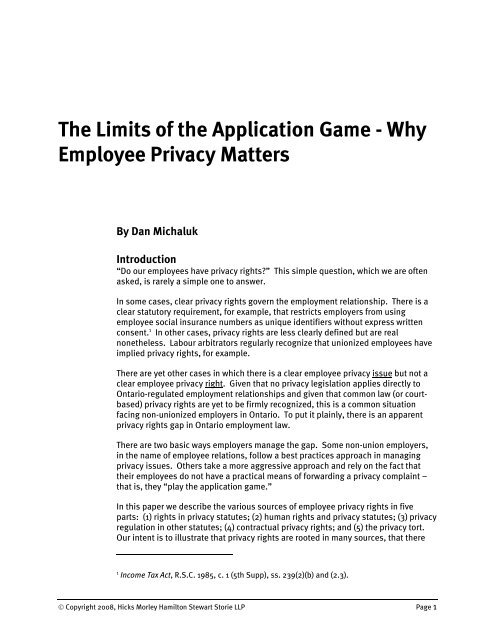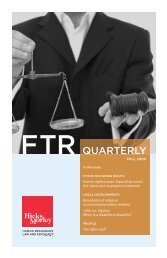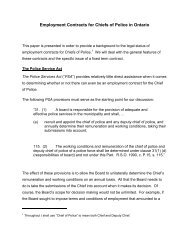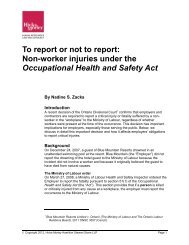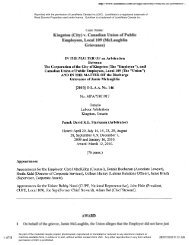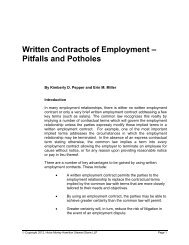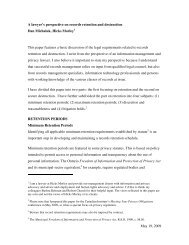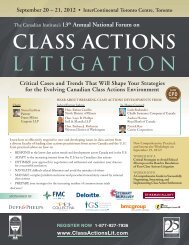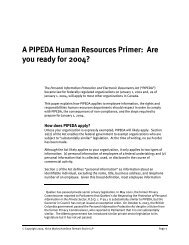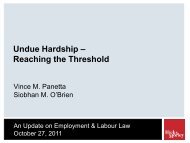The Limits of the Application Game - Why Employee ... - Hicks Morley
The Limits of the Application Game - Why Employee ... - Hicks Morley
The Limits of the Application Game - Why Employee ... - Hicks Morley
You also want an ePaper? Increase the reach of your titles
YUMPU automatically turns print PDFs into web optimized ePapers that Google loves.
<strong>The</strong> <strong>Limits</strong> <strong>of</strong> <strong>the</strong> <strong>Application</strong> <strong>Game</strong> - <strong>Why</strong><br />
<strong>Employee</strong> Privacy Matters<br />
By Dan Michaluk<br />
Introduction<br />
“Do our employees have privacy rights” This simple question, which we are <strong>of</strong>ten<br />
asked, is rarely a simple one to answer.<br />
In some cases, clear privacy rights govern <strong>the</strong> employment relationship. <strong>The</strong>re is a<br />
clear statutory requirement, for example, that restricts employers from using<br />
employee social insurance numbers as unique identifiers without express written<br />
consent. 1 In o<strong>the</strong>r cases, privacy rights are less clearly defined but are real<br />
none<strong>the</strong>less. Labour arbitrators regularly recognize that unionized employees have<br />
implied privacy rights, for example.<br />
<strong>The</strong>re are yet o<strong>the</strong>r cases in which <strong>the</strong>re is a clear employee privacy issue but not a<br />
clear employee privacy right. Given that no privacy legislation applies directly to<br />
Ontario-regulated employment relationships and given that common law (or courtbased)<br />
privacy rights are yet to be firmly recognized, this is a common situation<br />
facing non-unionized employers in Ontario. To put it plainly, <strong>the</strong>re is an apparent<br />
privacy rights gap in Ontario employment law.<br />
<strong>The</strong>re are two basic ways employers manage <strong>the</strong> gap. Some non-union employers,<br />
in <strong>the</strong> name <strong>of</strong> employee relations, follow a best practices approach in managing<br />
privacy issues. O<strong>the</strong>rs take a more aggressive approach and rely on <strong>the</strong> fact that<br />
<strong>the</strong>ir employees do not have a practical means <strong>of</strong> forwarding a privacy complaint –<br />
that is, <strong>the</strong>y “play <strong>the</strong> application game.”<br />
In this paper we describe <strong>the</strong> various sources <strong>of</strong> employee privacy rights in five<br />
parts: (1) rights in privacy statutes; (2) human rights and privacy statutes; (3) privacy<br />
regulation in o<strong>the</strong>r statutes; (4) contractual privacy rights; and (5) <strong>the</strong> privacy tort.<br />
Our intent is to illustrate that privacy rights are rooted in many sources, that <strong>the</strong>re<br />
1<br />
Income Tax Act, R.S.C. 1985, c. 1 (5th Supp), ss. 239(2)(b) and (2.3).<br />
© Copyright 2008, <strong>Hicks</strong> <strong>Morley</strong> Hamilton Stewart Storie LLP Page 1
are risks <strong>of</strong> newly-developing sources <strong>of</strong> employee privacy rights and, overall, that<br />
employee privacy does matter.<br />
Rights in Privacy Statutes<br />
Privacy statutes are <strong>of</strong>ten referred to by <strong>the</strong>ir acronyms. In Ontario, <strong>the</strong> relevant<br />
statutes are:<br />
• Personal Information Protection and Electronic Documents Act (PIPEDA); 2<br />
• Personal Health Information Protection Act, 2004 (PHIPA); 3<br />
• Municipal Freedom <strong>of</strong> Information and Protection <strong>of</strong> Privacy Act (MFIPPA); 4<br />
and<br />
• Freedom <strong>of</strong> Information and Protection <strong>of</strong> Privacy (FIPPA). 5<br />
In this part, we describe how PIPEDA, PHIPA, MFIPPA and FIPPA apply to employees<br />
in Ontario. As you will see, PIPEDA contains <strong>the</strong> only statue-based privacy code that<br />
regulates employees working in Ontario, but it only applies directly to employees<br />
who work for federally-regulated employers.<br />
PIPEDA<br />
PIPEDA regulates employment in banks, telecommunications companies, interprovincial<br />
transport companies, airlines and o<strong>the</strong>r federally-regulated employers.<br />
<strong>The</strong>se employers must abide by PIPEDA and its ten privacy principles, including <strong>the</strong><br />
principle that collections, uses and disclosures <strong>of</strong> employee personal information be<br />
based on informed (express or implied) consent, 6 and <strong>the</strong> principle that personal<br />
information should only be collected, used and disclosed as necessary for a<br />
reasonable purpose. 7<br />
PIPEDA does not apply directly to employers regulated by Ontario employment law.<br />
Generally speaking, employees who work for <strong>the</strong>se employers do not enjoy <strong>the</strong><br />
protection <strong>of</strong> a statute-based privacy code.<br />
2<br />
S.C. 2000, c. 5.<br />
3<br />
S.O. 2004, c. 3, Sch. A.<br />
4<br />
R.S.O. 1990, c. M.56.<br />
5<br />
R.S.O. 1990, c. F.31.<br />
6<br />
PIPEDA, Principle 3.<br />
7<br />
PIPEDA, section 5(3), Principle 4 and Principle 5. As this paper is providing an overview <strong>of</strong><br />
privacy issues facing employers, throughout this paper we have provided a simplified<br />
description <strong>of</strong> <strong>the</strong> statutory requirements.<br />
© Copyright 2008, <strong>Hicks</strong> <strong>Morley</strong> Hamilton Stewart Storie LLP Page 2
<strong>The</strong>re is still some debate about whe<strong>the</strong>r PIPEDA can apply indirectly to Ontarioregulated<br />
employers who outsource functions to commercial service providers<br />
because PIPEDA applies to personal information that is collected, used and<br />
disclosed “in <strong>the</strong> course <strong>of</strong> commercial activity”. On one <strong>the</strong>ory, when an employer<br />
outsourcers an employment administration function (e.g. payroll administration), an<br />
agency relationship exists and <strong>the</strong>re is no “disclosure” that attracts <strong>the</strong> application<br />
<strong>of</strong> PIPEDA. On ano<strong>the</strong>r <strong>the</strong>ory, <strong>the</strong> outsourcing <strong>of</strong> employment administration<br />
functions by Ontario-regulated employers is regulated by PIPEDA because<br />
outsourcing requires employee personal information to be disclosed and used “in<br />
<strong>the</strong> course <strong>of</strong> commercial activity” between <strong>the</strong> employer and <strong>the</strong> service provider.<br />
This issue is far from certain, and prudent employers will keep in mind PIPEDA’s<br />
privacy principles when engaging third party commercial service providers to<br />
process or o<strong>the</strong>rwise handle employee personal information.<br />
PHIPA<br />
PHIPA is significant to Ontario employers, but has limited application to employers<br />
who do not provide health care to <strong>the</strong>ir employees.<br />
In <strong>the</strong> ordinary course, <strong>the</strong> only section <strong>of</strong> PHIPA that regulates <strong>the</strong> employment<br />
relationship is section 49. This section effectively requires employers to collect<br />
information for <strong>the</strong>ir employment-related purposes based on express written<br />
consent and to use and disclose that information strictly within <strong>the</strong> limits <strong>of</strong> <strong>the</strong><br />
written consent. 8 An employer’s ability to ask an employee for his or her consent is<br />
not directly regulated by PHIPA, but PHIPA does require health care practitioners to<br />
assess <strong>the</strong> necessity <strong>of</strong> <strong>the</strong> employer’s request. 9<br />
Employers who provide health care to employees are fully regulated by PHIPA in<br />
undertaking this activity – that is, <strong>the</strong>y are bound by all elements <strong>of</strong> <strong>the</strong> PHIPA<br />
privacy code.<br />
<strong>The</strong> definition <strong>of</strong> health care is critical for employers to understand because <strong>the</strong>ir<br />
obligations vis-à-vis employee medical information are very different depending <strong>the</strong><br />
reason <strong>the</strong> records were generated. Although health care is defined broadly, it likely<br />
does not include occupational assessments. 10 <strong>The</strong>refore, employers who employ or<br />
retain medical pr<strong>of</strong>essionals to wear “two hats” (by providing health care and<br />
8<br />
PHIPA, section 49.<br />
9<br />
PHIPA, sections 29 and 30.<br />
10<br />
PHIPA Adjudication Summary HC-050014-1 (26 October 2006, IPC/Ontario) and Halyna<br />
Perun et al., Guide to <strong>the</strong> Ontario Personal Health Information Protection Act (Toronto: Irwin<br />
Law, 2005) at 41 – 42. But note Hooper v. College <strong>of</strong> Nurses <strong>of</strong> Ontario (2006), 271 D.L.R.<br />
(4th) 229 (Ont. Div. Ct.), 2006 CanLII 22656 (ON S.C.D.C.).<br />
© Copyright 2008, <strong>Hicks</strong> <strong>Morley</strong> Hamilton Stewart Storie LLP Page 3
performing occupational assessments) should be particularly careful in keeping<br />
<strong>the</strong>ir health care and assessment processes and records separate.<br />
MFIPPA and FIPPA<br />
<strong>The</strong>re are two public sector freedom <strong>of</strong> information and privacy statutes: <strong>the</strong><br />
Municipal Freedom <strong>of</strong> Information and Protection <strong>of</strong> Privacy Act (MFIPPA) and <strong>the</strong><br />
Freedom <strong>of</strong> Information and Protection <strong>of</strong> Privacy (FIPPA). Both MFIPPA and FIPPA<br />
include a very broad exclusion for employment-related records. 11 In light <strong>of</strong> a<br />
significant 2001 decision on <strong>the</strong> exclusion by <strong>the</strong> Ontario Court <strong>of</strong> Appeal, 12 <strong>the</strong><br />
Commissioner herself has acknowledged that <strong>the</strong> privacy <strong>of</strong> public sector employees<br />
in Ontario is not protected under <strong>the</strong> statutes. In lobbying for an amendment to <strong>the</strong><br />
exclusion, she has stated, “Public sector employees are currently precluded from<br />
obtaining access to most employment-related records about <strong>the</strong>mselves, and from<br />
filing a privacy complaint if <strong>the</strong>y feel that <strong>the</strong>ir personal information has been<br />
improperly collected, used, disclosed or retained”. 13<br />
Human Rights Legislation and Privacy<br />
An employee has an obligation to provide an employer with medical information that<br />
is reasonably necessary to <strong>the</strong> administration <strong>of</strong> <strong>the</strong> employment relationship,<br />
including (1) to determine <strong>the</strong> validity <strong>of</strong> an absence, (2) to determine eligibility for<br />
an income protection benefit, (3) to develop accommodation plans and proposals<br />
and (4) to ensure that employees can safely return to work.<br />
Employers who do not respect <strong>the</strong> reasonable necessity requirement in managing<br />
employees who suffer from disabilities or perceived disabilities do, however, expose<br />
<strong>the</strong>mselves to potential human rights liability. In fact, human rights claims that arise<br />
out <strong>of</strong> a failed accommodation process <strong>of</strong>ten involve disputes about <strong>the</strong> necessity <strong>of</strong><br />
an employer’s request for information – essentially a matter <strong>of</strong> individual privacy.<br />
<strong>The</strong> Alberta Court <strong>of</strong> Queen’s Bench recently noted <strong>the</strong> link between human rights<br />
and privacy rights in Kellogg Brown & Root:<br />
… some may argue that [an anti-discrimination right] should not do<br />
<strong>the</strong> work <strong>of</strong> privacy rights. However, equality rights, human rights<br />
and privacy rights do not exist in compartments. In Law <strong>the</strong> Supreme<br />
Court stated that a primary purpose <strong>of</strong> equality rights is <strong>the</strong><br />
protection <strong>of</strong> <strong>the</strong> essential human dignity <strong>of</strong> each individual. <strong>The</strong> Act<br />
identifies human dignity and equality as fundamental principles to<br />
11<br />
MFIPPA, section 52(3) and FIPPA, section 65(6).<br />
12<br />
Ontario (Solicitor General) v. Mitchinson (2001), 55 O.R. (3d) 355 (Ont. C.A.), 2001 CanLII<br />
8582 (ON C.A.).<br />
13<br />
Information and Privacy Commissioner/Ontario, 2004 Annual Report:<br />
.<br />
© Copyright 2008, <strong>Hicks</strong> <strong>Morley</strong> Hamilton Stewart Storie LLP Page 4
e cherished and protected in Alberta…Human dignity is <strong>the</strong>refore at<br />
<strong>the</strong> core <strong>of</strong> both privacy rights and equality rights. To extend <strong>the</strong><br />
protection <strong>of</strong> perceived disability to individuals who test positive on<br />
this type <strong>of</strong> drug test within this type <strong>of</strong> policy promotes <strong>the</strong><br />
protection <strong>of</strong> human dignity and streng<strong>the</strong>ns ra<strong>the</strong>r than dilutes antidiscrimination<br />
norms. 14<br />
Privacy Regulation in O<strong>the</strong>r Statutes<br />
<strong>The</strong>re are also privacy rights and restrictions scattered throughout <strong>the</strong> federal and<br />
provincial statute books. We cannot list all such provisions, but we have identified<br />
<strong>the</strong> most significant statutory provisions in an Appendix to this paper.<br />
Contractual Privacy Rights<br />
Currently, for Ontario-regulated employers, <strong>the</strong> implied contractual obligations <strong>of</strong><br />
unionized and non-unionized employers differ.<br />
Unionized Employers and Collective Agreement Rights<br />
Although collective agreements rarely contain express privacy protections,<br />
arbitrators have willingly protected unionized employees’ privacy rights by relying<br />
on clauses that specify that work rules must be reasonable, 15 by recognizing implied<br />
restrictions on management rights, 16 and by recognizing a right <strong>of</strong> privacy based on<br />
<strong>the</strong> “common law <strong>of</strong> <strong>the</strong> unionized workplace”. 17 Based on <strong>the</strong> prevailing arbitral<br />
case law, employers have a fairly limited ability to raise successful preliminary<br />
objections to privacy complaints by arguing that <strong>the</strong>re is no right in <strong>the</strong> collective<br />
agreement that has been violated.<br />
Non-Unionized Employers and Constructive Dismissal Claims<br />
<strong>The</strong> best way <strong>of</strong> describing <strong>the</strong> position <strong>of</strong> non-unionized employees <strong>of</strong> Ontarioregulated<br />
employers is that <strong>the</strong>y have no practical means <strong>of</strong> asserting a privacy<br />
14<br />
Alberta (Human Rights and Citizenship Commission) v. Kellogg Brown & Root (Canada) Co.<br />
(2006), 267 D.L.R. (4th) 639 (Alta. Q.B.) at 675, 676, overturned on o<strong>the</strong>r grounds 2007 ABCA<br />
426 (CanLII).<br />
15<br />
See e.g. Re United Food and Commercial Workers Union, Local 1000A and Janes Family<br />
Foods (Surveillance Grievance), [2006] O.L.A.A. No. 611 (Trachuck) (QL).<br />
16<br />
See e.g. Re Lenworth Metal Products Ltd. and United Steelworkers <strong>of</strong> America, Local 3950<br />
(1999), 80 L.A.C. (4th) 426 (Armstrong), upheld on judicial review (2000), 29 Admin. L.R. (3d)<br />
258 (Ont. Div. Ct.).<br />
17<br />
See e.g. Re Labourers’ International Union <strong>of</strong> North America, Local 625 and Prestressed<br />
Systems Inc. (Roberts Grievance) (2005), 137 L.A.C. (4th) 193 (Lynk). But see, among o<strong>the</strong>rs,<br />
A.T.U., Local 569 v. Edmonton City (2004), 124 L.A.C. (4th) 225 (Alta. Q.B.) and Re Canadian<br />
Timken Ltd. and U.S.W.A., Local 4906 (Hutchin) (2001), 98 L.A.C. (4th) 129 (Welling).<br />
© Copyright 2008, <strong>Hicks</strong> <strong>Morley</strong> Hamilton Stewart Storie LLP Page 5
complaint unless <strong>the</strong>ir employer has created some policy or o<strong>the</strong>r express<br />
contractual basis for making such a complaint. In <strong>the</strong>ory, if <strong>the</strong>se employees have<br />
privacy complaints that amount to a “fundamental breach” <strong>of</strong> <strong>the</strong> employment<br />
relationship, <strong>the</strong>y may quit and claim constructive dismissal. However, this option<br />
has not yet proven to be appealing, and we are not aware <strong>of</strong> any constructive<br />
dismissal claims advanced on <strong>the</strong> basis <strong>of</strong> a privacy breach alone.<br />
This does not mean that employers should be blind to <strong>the</strong> risk <strong>of</strong> constructive<br />
dismissal claims based on privacy claims when managing employees. <strong>The</strong> Honda v.<br />
Keays decision is a well-known recent case in which an employer was found to have<br />
constructively dismissed an employee who suffered from chronic fatigue syndrome<br />
by being overly-aggressive in seeking medical information about <strong>the</strong> employee’s<br />
condition. 18 Although <strong>the</strong> Keays decision does not use <strong>the</strong> language <strong>of</strong> privacy to<br />
express why <strong>the</strong> employer breached its contract <strong>of</strong> employment and constructively<br />
dismissed Mr. Keays, <strong>the</strong> interest protected by <strong>the</strong> Court in Keays is analogous to a<br />
privacy interest.<br />
<strong>The</strong> Privacy Tort<br />
<strong>The</strong> traditional view <strong>of</strong> <strong>the</strong> common law is that <strong>the</strong>re is no tort <strong>of</strong> invasion <strong>of</strong> privacy.<br />
For example, in <strong>the</strong> case <strong>of</strong> Euteneier v. Lee, <strong>the</strong> Ontario Court <strong>of</strong> Appeal made <strong>the</strong><br />
following comments:<br />
But [<strong>the</strong> respondent] properly conceded in oral argument before this<br />
court that <strong>the</strong>re is no ‘free-standing’ right to dignity or privacy under<br />
<strong>the</strong> Charter or at common law. For example, although respect for<br />
human dignity underlies many <strong>of</strong> <strong>the</strong> rights and freedoms in <strong>the</strong><br />
Charter, it is not a principle <strong>of</strong> fundamental justice under s. 7 <strong>of</strong> <strong>the</strong><br />
Charter. 19<br />
However, over <strong>the</strong> years, common law courts in Ontario have grappled with whe<strong>the</strong>r<br />
such a tort does, or at least should, exist. In one recent claim, an employee claimed<br />
that his employer committed <strong>the</strong> tort when <strong>the</strong> employer conducted a credit check<br />
without notice or consent. <strong>The</strong> employer brought a motion to strike <strong>the</strong> claim as not<br />
disclosing a reasonable cause <strong>of</strong> action. In Somwar v. McDonald’s Restaurants <strong>of</strong><br />
Canada Inc., 20 Madam Justice Stinson <strong>of</strong> <strong>the</strong> Ontario Superior Court <strong>of</strong> Justice<br />
dismissed <strong>the</strong> employer’s motion, and stated as follows:<br />
With advancements in technology, personal data <strong>of</strong> an individual can<br />
now be collected, accessed (properly and improperly), and<br />
18<br />
(2006), 82 O.R. (3d) 161 (C.A.), 2006 CanLII 33191 (ON C.A.).<br />
19<br />
(2005), 77 O.R. (3d) 621 (C.A.) at 637, 2005 CanLII 33024 (ON C.A.).<br />
20<br />
(2006), 79 O.R. (3d) 172 (S.C.J.), 2006 CanLII 202 (ON S.C.).<br />
© Copyright 2008, <strong>Hicks</strong> <strong>Morley</strong> Hamilton Stewart Storie LLP Page 6
disseminated more easily than ever before. <strong>The</strong>re is a resulting<br />
increased concern in our society about <strong>the</strong> risk <strong>of</strong> unauthorized<br />
access to an individual’s personal information. <strong>The</strong> traditional torts<br />
such as nuisance, trespass, and harassment may not provide<br />
adequate protection against infringement <strong>of</strong> an individual’s privacy<br />
interests. Protection <strong>of</strong> those privacy interests by providing a<br />
common law remedy for <strong>the</strong>ir violation would be consistent with<br />
Charter values and an “incremental revision” and logical extension <strong>of</strong><br />
<strong>the</strong> existing jurisprudence. 21<br />
This was a preliminary motion only, but Stinson J.’s dicta is strong. <strong>The</strong> above<br />
paragraph was commented upon positively by ano<strong>the</strong>r judge <strong>of</strong> <strong>the</strong> Ontario Superior<br />
Court <strong>of</strong> Justice later in 2006. 22 Last year, a small claims court judge relied on <strong>the</strong><br />
Somwar case in awarding damages for <strong>the</strong> tort <strong>of</strong> invasion <strong>of</strong> privacy. 23 Based on<br />
<strong>the</strong>se developments, employers ought to beware <strong>of</strong> <strong>the</strong> potential for tort-based<br />
liability for privacy violations in respect <strong>of</strong> <strong>the</strong>ir current and former employees. 24<br />
Conclusion<br />
It should be apparent from <strong>the</strong> above discussion that employee privacy rights do<br />
exist in Ontario. And while <strong>the</strong> scattering <strong>of</strong> privacy-protective provisions<br />
throughout <strong>the</strong> statute book and <strong>the</strong> nascent status <strong>of</strong> a tort <strong>of</strong> invasion <strong>of</strong> privacy<br />
leave employers with <strong>the</strong> option <strong>of</strong> managing around privacy rights and playing <strong>the</strong><br />
application game, this approach to managing employee privacy comes with legal<br />
and practical risks. Fur<strong>the</strong>rmore, and as noted by <strong>the</strong> Alberta Court <strong>of</strong> Queen’s<br />
Bench in <strong>the</strong> Kellogg Brown & Root case, respect for human dignity is at <strong>the</strong> core <strong>of</strong><br />
privacy rights. This view means that <strong>the</strong> availability <strong>of</strong> <strong>the</strong> application game may<br />
narrow as <strong>the</strong> law develops. In short, employee privacy matters.<br />
21<br />
Ibid. at 181-182.<br />
22<br />
Shred-Tech v. Viveen, 2006 CanLII 41004 (ON S.C.).<br />
23<br />
Caltagirone v. Scozzari-Cloutier, [2007] O.J. No. 4003 (S.C.J.) (QL).<br />
24<br />
<strong>The</strong> risk <strong>of</strong> negligence claims for data breaches is also a possibility – see.g. Young v. Bella,<br />
[2006] 1 S.C.R. 108, 2006 SCC 3 (CanLII).<br />
© Copyright 2008, <strong>Hicks</strong> <strong>Morley</strong> Hamilton Stewart Storie LLP Page 7
Appendix – Privacy Regulation in O<strong>the</strong>r Statutes<br />
Criminal Code, R.S.C. 1985, c.<br />
C-46 – Canada<br />
Consumer Reporting Act, R.S.O.<br />
1990, c. C.33 – Ontario<br />
Confidentiality – Prohibition on Wiretaps<br />
• Prohibition against wilfully intercepting a private<br />
communication by means <strong>of</strong> any electro-magnetic,<br />
acoustic, mechanical or o<strong>the</strong>r device (s. 184).<br />
Confidentiality – Requesting Consumer Report<br />
• Intention to use for employment purposes must<br />
be established (s. 8(1) and (2)).<br />
• Prohibition against requesting or obtaining<br />
consumer reports without written notice (s. 10(2)).<br />
• Notice must take specific form (s. 10(6)).<br />
• Notice <strong>of</strong> adverse action must be given per <strong>the</strong><br />
statute (s. 10(7)).<br />
• Prohibition against obtaining o<strong>the</strong>r information<br />
without notice (s. 11(1)).<br />
• Offence for any contravention up to $25,000<br />
(individual) or $100,000 (corporation) (s. 23).<br />
Employment Standards Act,<br />
2000, S.O. 2000, c. 41 –<br />
Ontario<br />
Physical Privacy - Lie Detector Tests<br />
• Prohibition against requiring, enabling or<br />
influencing an employee to take a lie detector test<br />
(s. 70(1)).<br />
• Prohibition against disclosing to an employer that<br />
an employee has taken a test and disclosing<br />
results <strong>of</strong> test (s. 70(2)).<br />
Permissible Disclosure - Building Service Providers<br />
• Disclosure <strong>of</strong> prescribed employee information to<br />
possible new provider, new providers, and<br />
owner/managers permitted (s. 77 <strong>of</strong> <strong>the</strong> Act, and<br />
s. 3 <strong>of</strong> O. Reg. 287/01).<br />
• Obligation to keep confidential, use only for<br />
determining termination, severance and vacation<br />
obligations or potential obligations under Part XIX<br />
<strong>of</strong> <strong>the</strong> Act (s. 78).<br />
© Copyright 2008, <strong>Hicks</strong> <strong>Morley</strong> Hamilton Stewart Storie LLP Page 8
Income Tax Act, R.S.C. 1985, c.<br />
1 (5th Supp) – Canada<br />
Occupational Health and Safety<br />
Act, R.S.O. 1990, c. O.1 –<br />
Ontario<br />
Confidentiality – Social Insurance Numbers<br />
• Not an identifier - SIN not to be used,<br />
communicated or allowed to be communicated for<br />
purposes o<strong>the</strong>r than authorized under <strong>the</strong> Act<br />
without an individual’s written consent (s.<br />
237(2)(b)).<br />
• Not an identifier (<strong>of</strong>fence) – Offence to knowingly<br />
use, communicate or allow to be communicated<br />
without written consent – punishable by fine not<br />
exceeding $5,000 or imprisonment not exceeding<br />
12 months, or both (s. 239(2.3)).<br />
Confidentiality - <strong>Employee</strong> Health Records<br />
Confidentiality <strong>of</strong> medical information ga<strong>the</strong>red under <strong>the</strong><br />
Act (s. 63(1))<br />
• Employer shall not seek access to a worker’s<br />
health record without consent (s. 63(2))<br />
• Section 63 <strong>of</strong> <strong>the</strong> Act prevails despite anything to<br />
<strong>the</strong> contrary in <strong>the</strong> PHIPA, 2004 (s. 63(6))<br />
Mandatory Collection (Medical Surveillance Programs)<br />
• Employer has duty to establish a medical<br />
surveillance program as prescribed by regulations<br />
(s. 26(1)(h))<br />
• Worker consent required (s. 26(3))<br />
• Programs all relate to exposure to certain<br />
designated substances<br />
© Copyright 2008, <strong>Hicks</strong> <strong>Morley</strong> Hamilton Stewart Storie LLP Page 9
Workplace Safety and<br />
Insurance Act, 1997, S.O. 1997,<br />
c. 16, Sch. A – Ontario<br />
<strong>Employee</strong> Access – Board File<br />
Worker has right to request access to <strong>the</strong> file kept by<br />
<strong>the</strong> Board “if <strong>the</strong>re is an issue in dispute” and <strong>the</strong><br />
Board does not believe <strong>the</strong> worker will be harmed by<br />
seeing <strong>the</strong> file (s. 57).<br />
Confidentiality<br />
• Functional Abilities Form – Employer and its<br />
representative prohibited from disclosing<br />
information contained in functional abilities form<br />
except to a person assisting <strong>the</strong> employer return<br />
<strong>the</strong> person to work (s. 37(4)).<br />
• Documents Disclosed by Board - Employer must<br />
keep information disclosed from Board<br />
confidential (s. 59).<br />
• General - Employer must not disclose health<br />
information received from a health care<br />
practitioner, hospital, health facility or any o<strong>the</strong>r<br />
person or organization about a worker who has<br />
made a claim for benefits unless specifically<br />
permitted by <strong>the</strong> Act (s. 181).<br />
• Offence – failure to comply with <strong>the</strong> above<br />
punishable by fine <strong>of</strong> up to $100,000 (s. 150).<br />
© Copyright 2008, <strong>Hicks</strong> <strong>Morley</strong> Hamilton Stewart Storie LLP Page 10


